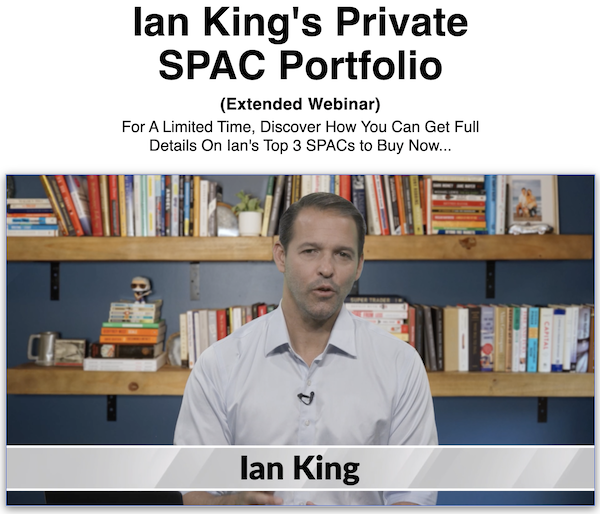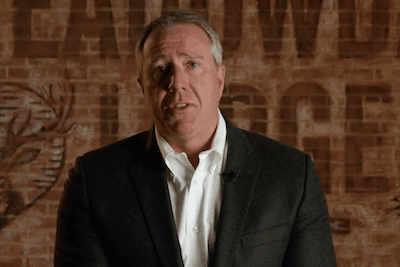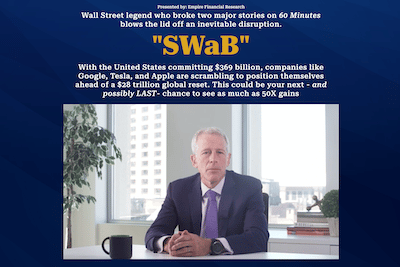I recently attended an “extended webinar” featuring Banyan Hill Publishing’s Ian King, which was all about his “Private SPAC Portfolio.”
According to the presentation, over 700 companies worth over $2.3 trillion could soon go public, and Ian King says he’s particularly interested in three SPACs.

To find out what companies Ian is bullish on, however, you need to join his advisory service, New Era Fortunes, for $2,995. And since not everyone has that sort of money lying around, I decided to put this post together to help you determine if it’s worthwhile.
Let’s start by looking at what SPACs are all about and why people invest in them. Then we’ll unpack Ian’s Private SPAC Portfolio presentation to figure out what he’s pitching.
What’s a SPAC and Why Do They Exist?
Chances are you’ve heard the term SPAC at some point. They seem to be getting more and more popular lately, especially among finance gurus.
But what exactly is a SPAC?
A Special Purpose Acquisition Company (SPAC) is a company that’s typically created for the purpose of acquiring or merging with an existing private company.
Put differently; a SPAC is essentially a “shell” company that exists to raise funds from investors, with the goal of using those funds to help take another company public.
Most companies go public (get listed on the public stock exchange) through what’s known as an Initial Public Offering (IPO).
However, the IPO process can be costly and time-consuming, and SPACs provide private companies with a potentially cheaper, faster alternative to getting publicly listed.
And from an investment point of view, SPACs can more or less give you the chance to invest in a private company before it goes public.
In this respect, it’s similar to investing in a pre-IPO deal where you invest in a private company before the general public can buy shares on the stock exchange.
However, with a SPAC, you’re not investing directly in a private company. Instead, you’re investing in the SPAC and hoping it merges with the private company down the road.
Another difference between pre-IPOs and SPACs is that pre-IPOs are typically limited to institutional investors given the amount of money needed to participate and there are restrictions in place about who can invest. Whereas virtually anyone can invest in a publicly listed SPAC.
There are potentially significant risks involved with this sort of thing, though.
For example, depending on what SPAC you invest in, and when, you may have no idea what company you are ultimately investing in. In other words, it may not be clear which company the SPAC is going to merge with or acquire. And there are no guarantees the SPAC will succeed.
So I recommend doing your own research on this topic to make sure you have a clear understanding of what a SPAC is and the risks involved. I’ve shared my understanding of how they work. And hopefully, it gives you a general idea. But there’s a lot more to it.
Anyway, now that we’ve covered the basics of SPACs, let’s unpack Ian King’s presentation.
Ian King’s Private SPAC Portfolio Teaser
Ian King began the presentation by talking about how traditional IPOs are declining in popularity while SPACs are becoming increasingly popular among retail investors.
He also says, “there’s a lot of money to be made investing in SPACs,” but on the same token, it’s possible to lose money if you don’t know what you’re doing. Specifically, he says that retail investors “could be putting their fortunes and their futures in danger” with SPACs.
Long story short, this is why Ian King said he put the presentation together, to show his readers the benefits and the potential pitfalls associated with SPAC deals.
Regarding the potential benefits, Ian King says there are “four powerful factors” working for SPACs that traditional IPOs don’t have.
First, he points out that SPACs allow anyone to secure shares in private companies, whereas pre-IPO deals often require you to be an accredited investor or institutional investor.
Second, Ian says SPACs are “designed to rocket higher” due to a “special trigger event.”
What does he mean by “trigger event?”
Ian explains that the trigger event he’s referring to is when an agreement is made between the SPAC and the private company it plans to merge with. Essentially, what he’s saying is that when the announcement is made, the SPACs share price can soar.
This is when a definitive agreement is made between the SPAC and the private company it will merge with.
Once this “trigger event” is announced, shares can start to soar even before the merger.
Source: https://pro.banyanhill.com/p/WMC-KIN2021-002/EKINXB25/Full
Third, Ian says SPACs “almost always trade right around $10 coming out of the gate.” And based on this article on the SEC website about SPACs, that appears to be true. And from what I can gather, Ian is suggesting this is good because you know how much you’re going to pay.
Fourth, Ian King says you’re initial downside is limited with SPACs:
If the trigger event never happens…
You are almost always contractually guaranteed to get your money back…at the value of the underlying cash holdings, which is usually around $10.
That means your initial downside is limited by law.
What does he mean by this?
From what I understand, Ian is suggesting that you “could get the full $10 back on your investment” if the company doesn’t find a suitable deal. And, while I’m no expert when it comes to SPACs, what he’s saying appears to be true.
In short, when you invest in a SPAC during its IPO, the funds typically go into a trust account, minus certain fees and expenses. And if the SPAC doesn’t find a suitable deal within a set time period (usually two years), investors may be entitled to their pro-rata share of the trust account based on the SPAC’s IPO price.
For example, if the SPAC IPOs at $10 per share and you bought one share of the SPAC for $15 at some point down the road, you could only hope to recover up to $10.
Again, I recommend you do your own research on this before deciding anything. And please don’t consider anything I’m saying to be financial advice. It’s not. But that’s my take on how it works and these are the potential benefits of SPACs that Ian King talks about in the presentation.
He also talks about some of the potential drawbacks.
The first drawback he talks about has to do with who’s running the SPAC. According to Ian, it’s not just investment experts starting SPACs; athletes and politicians are getting involved, so he says it’s essential to make sure that the person running the SPAC knows what they’re doing.
The second drawback he mentions is that SPACs often have two years to make a deal. So he says that you shouldn’t “invest more money than you’re comfortable committing for 12 to 36 months.”
He sums it up by saying that due diligence is “extraordinarily important” when it comes to picking the right SPACs and says he’s developed a “specific strategy” to find the best SPACs
That’s why I developed a specific strategy to identify SPACs with the highest probability of producing the biggest gains.
What does his strategy involve?
The strategy Ian King uses to find SPAC deals he believes have potential is similar to the strategy he uses with Strategic Fortunes. He likens his approach to a “funnel with five filters” that helps him identify the right opportunity at the right time.
Here’s an overview of how each “filter” (AKA step) works:
- The first step involves identifying a “tipping-point” trend. Ian says he looks for emerging trends that are on the verge of a breakthrough that could change our everyday lives.
- Next, Ian says he looks for companies with a line of business that’s underpriced by investors, which he refers to as an “X-factor.” For example, a new tech innovation.
- Third, he looks for momentum in sales, which he defines as company’s that are increasing their sales by at least 20% or more each year.
- The fourth step in Ian’s process is all about timing. He says that figuring out when to get involved with an investment is one of the most important parts of his strategy.
- Ian says the fifth and final step is all about investing in companies that “have the best chance to become the next Microsoft, the next Amazon, and the next Tesla.” Specifically, he looks for “small-cap disrupters” which means many of the companies he’s tracking have a market capitalization of less than $2 billion.
So, this is the strategy Ian King says he uses to identify SPACs with the highest potential, and he says that the best place to find these companies is “in the group of 700 private companies with valuations of $1 billion or more.”
He says these companies are “sitting on the IPO sidelines” and that they’re “worth more than $2.3 trillion.” And he uses his five-step system to identify the best ones.
Recommended: Go here to see my #1 rated stock advisory of 2024
What Are Ian King’s Top 3 SPACs to Buy Now?
According to the presentation, there are three SPACs Ian King recommends buying right away. However, he doesn’t reveal what these companies are. Instead, he details each recommendation in a report titled “Ian King’s Top 3 SPACs to Buy Now.”
And while he doesn’t specifically say anything about the companies he’s recommending, he does state that he and his team have “uncovered multiple opportunities that could rocket 10 times higher in the next 12 to 36 months.”
So, while I’m only speculating, it appears as though Ian is hoping that his SPAC picks see 10X gains within a few years. Of course, nothing is guaranteed, but this seems to be the goal.
In any case, the only way to access the report is to join New Era Fortunes because the report is essentially a bonus that comes with a New Era Fortunes subscription.
What Is New Era Fortunes?
New Era Fortunes is an investment advisory service run by Ian King of Banyan Hill Publishing. And the core focus of the service is on innovative small-cap stocks.
Small-cap companies are publicly listed U.S. stocks with a market capitalization of $300 million to $2 billion. And for the most part, the companies Ian recommends are small companies involved in some type of innovative technology or biotechnology.
For example, 5G, the Internet of Things (IoT), machine learning, electric vehicles, precision medicine, and artificial intelligence.
Not all of the opportunities he recommends involve SPACs, but most of his New Era Fortunes recommendations involve small tech companies.
Overall, the service is similar to Strategic Fortunes, as is the strategy he uses to find the companies he recommends. However, at $5,000 per year, New Era Fortunes is more expensive and, generally speaking, more speculative.
That said, if you sign up through the “private SPAC portfolio” presentation, the cost of getting started with New Era Fortunes is $2,995 per year.
What do you get if you join?
The main part of the New Era Fortunes service is the monthly trade alerts. Each “alert” is sent via email and contains a new investment recommendation from Ian King, along with a complete breakdown of each pick and how it fits in with his five-step system.
You also get access to the model portfolio, which details all of his current recommendations, weekly webinar updates, and two bonus reports:
- Ian King’s Top 3 SPACs to Buy Now
- Ian King’s Top 3 “New Era” Windfall Opportunities
Does New Era Fortunes have a good track record?
According to Ian King, he’s recommended at least three triple-digit stocks over the past 14 months. However, overall, he says the service has achieved “average gains of 20% across 28 recommendations” with an average hold time of six months.
Of course, regardless of past performance, there’s no guarantee you’ll make money with any service going forward. But overall, the service appears to have a good track record.
Is Ian King the Real Deal?
Ian King is a real investment expert. He’s a former hedge fund manager who’s worked for investment firms like Salomon Brothers, Citigroup, and Peahi Capital.
All in all, he’s been in the finance game for over 20 years and got into the financial education space in 2017 when he joined Banyan Hill Publishing.
As of writing, the advisory services he runs include Strategic Fortunes, New Era Fortunes, Next Wave Crypto Fortunes, and he contributes to Winning Investor Daily.
What are Ian King’s top stock picks right now?
Ian recommends dozens of individual stocks across his services, which change depending on what’s going on in the market and what his research uncovers. And it depends on which service you join as to what recommendations you get access to.
That said, I have written about several of Ian King’s stock picks over the past couple of months. For instance, I reveal three tech stocks I think he’s teasing in my article about New Era Fortunes and I share my guess about his number one EV stock here.
So if you’re keen to get an idea of what stocks Ian King recommends, I recommend checking out either of those articles.
Bottom Line
Ian King’s “Private SPAC Portfolio” presentation is all about the potential benefits of investing in SPACs, or Special Purpose Acquisition Companies.
In short, he suggests that SPACs are better and more accessible to everyday investors than traditional IPO deals and says he’s particularly keen on three private companies, which he shares in a report titled “Ian King’s Top 3 SPACs to Buy Now.”
The only way to access this report, however, and find out what companies he’s teasing, is to join New Era Fortunes, which costs $2,995 per year.
Is it worth it?
Whether or not New Era Fortunes is worthwhile is something only you can decide.
On the one hand, it could be worthwhile if you’re interested in learning about small-cap companies and SPAC deals. Ian King has a solid track record in the space and has recommended some great companies over the years.
I wouldn’t expect every stock pick to see 10X gains because that’s almost certainly not going to happen, but overall the service could help you build a strong portfolio over time.
Either way, it’s worth pointing out that investing in SPACs and smaller-cap stocks can be risky. So it’s possible you could lose some or all of your investment when speculating on this sort of thing. And it’s not possible to get a cash refund on the service, either.
I don’t believe Ian King’s Private SPAC Portfolio presentation or his New Era Fortunes service is a scam, though. So, at the end of the day, whether or not it’s right for you will come down to your investment goals, preferences, and budget.












Please note: By submitting a comment using the above comment form, you confirm that you agree with the storage and handling of your data by this site as detailed in our Privacy Policy.